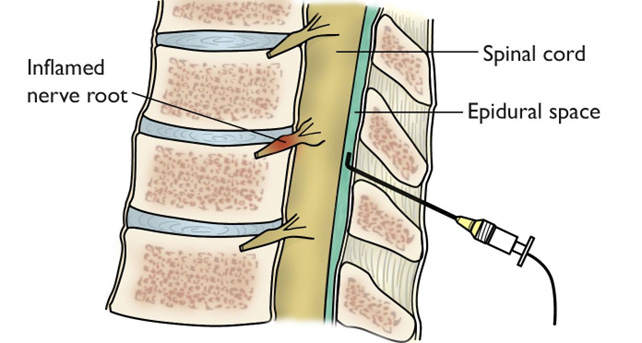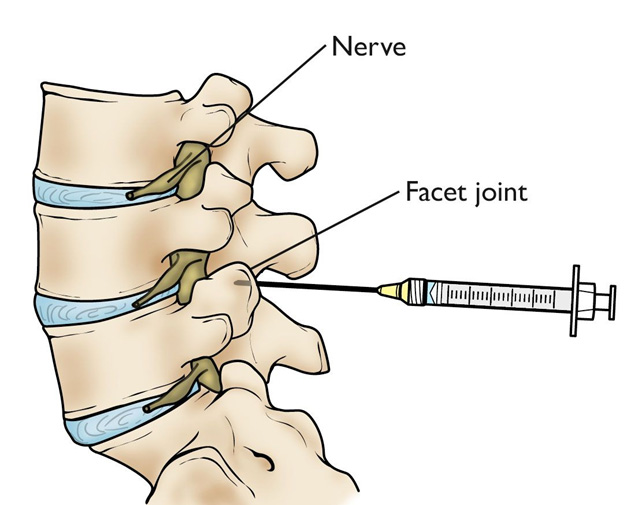Spinal injections are used in two ways. First, they can be performed to diagnose the source of back, leg, neck, or arm pain (diagnostic). Second, spinal injections can be used as a treatment to relieve pain (therapeutic). Simultaneous treatment nearly always includes an exercise program to improve or maintain spinal mobility (stretching exercises) and stability (strengthening exercises).
Procedure
Spinal injections are performed under x-ray guidance (fluoroscopy). This confirms correct placement of the medication and improves safety. Injected medications include local anesthetics and depot steroid injections apart from biological injections in select situations. The procedure is performed as a day care procedure, so patient can get back home the same day. If successful, spinal injections can provide medium to long term pain relief in select patients.
Types of Spinal Injections
Epidural Injections
Epidural injections are used to treat pain that starts in the spine and radiates to an arm or leg. Arm or leg pain often occurs when a nerve is inflamed or compressed ("pinched nerve").

Epidural injection in the spine.
Epidural injections involve injecting an anesthetic and/or an anti-inflammatory medication, such as a steroid (cortisone), near the affected nerve. The needle is placed into the “epidural space,” which is located just outside of the membrane that protects the spinal cord. The medication reduces the inflammation and lessens or resolves the pain. This type of epidural injection is a therapeutic one.
For diagnostic purposes, an epidural spinal injection can be done at a very specific, isolated nerve to determine if that particular nerve is the source of pain. Sometimes only an anesthetic is injected. The immediate response to the injection is closely monitored. If the pain is completely or nearly completely relieved, then that specific nerve is the primary cause of the pain symptoms. If there is little pain relief, then another source of pain exists.
Facet Joint Injections
Facet joint injections can also be done for both diagnostic and therapeutic reasons.

Facet joint injection in the lumbar spine (low back).
These types of injections are placed into and around the facet joints, which are the small joints located between each vertebra on the back of the spine. Facet joint injections are often used when pain is caused by degenerative/arthritic conditions or injury. They are used to treat neck, middle back, or low back pain. The pain does not have to be exclusively limited to the midline spine, as these problems can cause pain to radiate into the shoulders, buttocks, or upper legs.

Facet joint injection in the cervical spine (Neck).
For diagnostic purposes, facet joints can be injected in two ways: injecting anesthetic directly into the joint or anesthetizing the nerves carrying the pain signals away from the joint (medial branches of the nerve). If the majority of pain is relieved with anesthetic into the joint, then a therapeutic injection of a steroid may provide lasting neck or low back pain relief.
If anesthetic injections indicate that the nerve is the source of pain, the next step is to block the pain signals more permanently. This is done with radiofrequency ablation, or damaging the nerves that supply the joint with a "burning" technique.
Sacroiliac Joint Injections
Sacroiliac joint (SI joint) injections are similar to facet joint injections in many ways. The SI joints are located between the sacrum and ilium (pelvic) bones. Problems in the SI joints have been shown to cause pain in the low back, buttock, and leg. Typically, one joint is painful and causes pain on one side of the lower body. It is less common for both SI joints to be painful at the same time.
This joint can also be injected for both diagnostic and therapeutic purposes. Anesthetizing the SI joint by injection under x-ray guidance is considered the gold standard for diagnosing SI joint pain. A diagnostic injection of the sacroiliac joint with anesthetic should markedly diminish the amount of pain in a specific location of the low back, buttock, or upper leg. A therapeutic injection will typically include a steroid medication, with the goal of providing longer pain relief.
Sacroiliac joint injection in the pelvis.
Possible complications:
Spinal injection procedures are generally safe procedures. If complications occur, they are usually mild, self-limited and extremely rare. The risks of spinal injections include, but are not limited to the following:
- Bleeding
- Infection
- Nerve injury
- Arachnoiditis
- Paralysis
- Avascular necrosis
- Spinal headache
- Muscle weakness
- Increased pain
Common side effects from steroids include:
- Facial flushing
- Increased appetite
- Menstrual irregularities
- Nausea
- Diarrhoea
- Increased blood sugar
Some people are not good candidates for spinal injections. These include people with:
- Skin infection at the site of needle puncture
- Bleeding disorder or anticoagulation
- Uncontrolled high blood pressure or diabetes
- Allergy to contrast, anesthetics, or steroids
Spinal injections can be an useful minimally invasive treatment option in certain patients with spine related neck or back pain. The decision to perform the procedure will be based on clinical assessment and findings on spinal imaging. The procedure is technique dependent and requires expertise.
The author currently serves as the clinical lead - Dept of Orthopedics at Rela Hospital, Chennai



